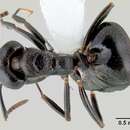en
names in breadcrumbs


From MacKay 1993:This species is usually collected in wet forest. It is a timid ant which nests in twigs, branches, trunks and fence posts, often in a faculative association with Crematogaster limata parabiotica (Swain, 1977, 1980). Nests are found in termitaria of Nasutitermes ephratae, N. corniger, and N. columbicus (Wheeler, 1936; Swain, 1977). Workers are found at extrafloral nectaries of Catostemma (Bombacaceae) (Lattke, 1986). It tends coccids and membracids. A single female was collected in March (Costa Rica - LACM). It is occasionally collected in quarantine on banana debris.[MacKay Literature Cited]
Dolichoderus debilis has been reported on numerous occasions nesting together with other species of ants. Forel (1898) observed Dolichoderus debilis and Crematogaster carinata (as C. limata parabiotica) inhabiting the same nest in Colombia, and coined the term parabiosis to describe the phenomenon of mutual nest sharing. Wheeler (1921) made similar observations. Davidson has multiple observations of parabiotic foraging between D. debilis and C. carinata in Peru (pers. comm.). Her studies indicate that, unlike many other species of Dolichoderus, D. debilis has no chemical defenses and has lost them because of its parabiotic associations with other strongly defended ants.
At Carara Biological Reserve in Costa Rica I observed a parabiotic association between D. debilis and C. carinata. Nests of both species were interdigitated in a cluster of dead branches. The nests of the two species were contiguous, with interconnections among chambers, but they were still largely segregated. In general the Crematogaster occupied smaller and more peripheral chambers, while the Dolichoderus occupied larger chambers in the center of the branches. In some peripheral chambers I found workers of both species together, but these chambers never contained brood. Any chamber with brood always contained only one species.
Guatemala south to Guianas, central and western Amazonia, Peru, and northern Bolivia. Costa Rica: southern Pacific lowlands.
Taxonomic history
Wheeler & Wheeler, 1951 PDF: 176 (l.).Combination in Dolichoderus (Monacis): Emery, 1894d PDF: 228.Combination in Monacis: Kempf, 1959c: 247.Combination in Hypoclinea: Lattke, 1987b PDF: 264.Combination in Dolichoderus: Shattuck, 1992c PDF: 77.Senior synonym of Dolichoderus debilis parabiotica: Kempf, 1959c: 247.Senior synonym of Dolichoderus debilis sieversi: Kempf, 1959c: 247.See also: MacKay, 1993b PDF: 47; Ortiz & Fernández, 2011 PDF: 61.- Venezuela. Azteca Alfari Em. - Las Trincheras, dans la cavite du Cecropia peltata.
Dolichoderus debilis is a species of ant in the genus Dolichoderus. Described by Emery in 1890, the species is found in many countries in two continents, including Bolivia, Brazil, Colombia, Costa Rica, French Guiana, Guatemala, Guyana, Panama, Suriname, Trinidad and Tobago and Venezuela.[1][2][3][4]
Dolichoderus debilis is a species of ant in the genus Dolichoderus. Described by Emery in 1890, the species is found in many countries in two continents, including Bolivia, Brazil, Colombia, Costa Rica, French Guiana, Guatemala, Guyana, Panama, Suriname, Trinidad and Tobago and Venezuela.